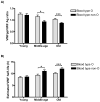Aging and ABO blood type influence von Willebrand factor and factor VIII levels through interrelated mechanisms
- PMID: 26875505
- PMCID: PMC5949873
- DOI: 10.1111/jth.13294
Aging and ABO blood type influence von Willebrand factor and factor VIII levels through interrelated mechanisms
Abstract
Essentials von Willebrand factor (VWF) and factor VIII (FVIII) levels are modulated by age and ABO status. The effect of aging and ABO blood type on VWF and FVIII was assessed in 207 normal individuals. Aging and ABO blood type showed combined and bidirectional influences on VWF and FVIII levels. Aging and ABO blood type influence VWF levels through both secretion and clearance mechanisms.
Summary: Background The effect of aging and ABO blood type on plasma levels of von Willebrand factor (VWF) and factor VIII (FVIII) have been widely reported; however, a comprehensive analysis of their combined effect has not been performed and the mechanisms responsible for the age-related changes have not been determined. Objectives To assess the influence of aging and ABO blood type on VWF and FVIII levels, and to evaluate the contribution of VWF secretion and clearance to the age-related changes. Methods A cross-sectional observational study was performed in a cohort of 207 normal individuals, whose levels of VWF, FVIII, VWF propeptide (VWFpp), VWFpp/VWF:Ag ratio and blood type A antigen content on VWF (A-VWF) were quantified. Results Aging and ABO blood type exerted interrelated effects on VWF and FVIII plasma levels, because the age-related increase in both proteins was significantly higher in type non-O individuals (β = 0.011 vs. 0.005). This increase with age in non-O subjects drove the differences between blood types in VWF levels, as the mean difference increased from 0.13 U/mL in the young to 0.57 U/mL in the old. Moreover, A-VWF was associated with both VWF antigen (β = 0.29; 95% confidence interval [CI], 0.09, 0.50) and VWF clearance (β = -0.15; 95% CI, -0.25, -0.06). We also documented an effect of ABO blood type on VWF secretion with aging, as old individuals with blood type non-O showed higher levels of VWFpp (mean difference 0.29 U/mL). Conclusions Aging and ABO blood type have an interrelated effect on VWF and FVIII levels, where the effect of one is significantly influenced by the presence of the other.
Keywords: ABO blood group system; aging; metabolic clearance rate; secretion; von Willebrand factor.
© 2016 International Society on Thrombosis and Haemostasis.
Conflict of interest statement
P. James receives research funding from Bayer, CSL Behring and Octapharma; honoraria from Baxalta, Biogen, Octapharma and CSL Behring and participates on advisory boards for CSL Behring, Baxalta and Biogen. D. Lillicrap receives research funding from Biogen, Bayer, CSL-Behring and Octapharma and participates on advisory boards for Baxalta, CSL-Behring and Biogen. The remaining authors declare no competing financial interests.
Figures






References
-
- Lenting PJ, Christophe OD, Denis C. von Willebrand factor biosynthesis, secretion, and clearance: connecting the far ends. Blood. 2015;125:2019–2028. - PubMed
-
- Vischer UM. von Willebrand factor, endothelial dysfunction, and cardiovascular disease. J Thromb Haemost. 2006;4:1186–1193. - PubMed
-
- Spiel AO, Gilbert JC, Jilma B. Von Willebrand factor in cardiovascular disease: Focus on acute coronary syndromes. Circulation. 2008;117:1449–1459. - PubMed
-
- Robertson J, Lillicrap D, James PD. Von Willebrand disease. Pediatr Clin North Am. 2008;55:377–392. - PubMed
Publication types
MeSH terms
Substances
Grants and funding
LinkOut - more resources
Full Text Sources
Other Literature Sources
Medical
Miscellaneous

